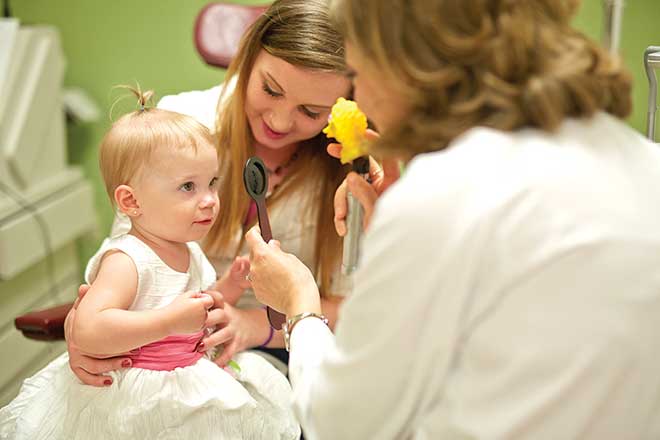Parents get overjoyed at each milestone in a child’s development, like when they first grasp an object or focus on a loved one’s face. But for some children, a misalignment of the eyes makes these small tasks a big challenge. The condition, strabismus, affects 3 to 4 percent of children in the U.S., causing vision impairment and slowing developmental skills. Fortunately for St. Louis families, the pediatric ophthalmology specialists at SLUCare Physician Group are experts in the latest treatments, and in offering families comprehensive, compassionate care.
SLUCare pediatric ophthalmologist Dr. Rafif Ghadban, an assistant professor of pediatric ophthalmology and adult strabismus at Saint Louis University School of Medicine, says the cause often is misunderstood—and unknown. “Children with special conditions, such as Down syndrome and cerebral palsy, are at a higher risk for developing strabismus, and, as with adults, it can be brought on by trauma or stroke.” The condition is classified by its cause or the direction of misalignment: esotropia (eye crosses in), exotropia (eye drifts out), hypotropia (eye drifts down) and hypertropia (eye drifts up).
Since strabismus strongly affects the development of depth perception, Ghadban stresses that parents need to bring in their children at the first sign of a problem. In some cases, it can be a symptom of a larger issue, like a tumor or excess fluid in the brain. “We have an entire team of specialists who work together to deal with pediatric eye problems,” Ghadban says. “SLUCare has an orthoptist who works specifically with children to measure eye movement. She measures all of my strabismus patients and
is great with kids.” As part of Pediatric Eye Disease Investigator Group (PEDIG), SLUCare physicians receive timely information about trials nationwide to help them stay up-to-date on the latest treatments and studies. SLUCare Physician Group also conducts its own pediatric ophthalmology research.
The first step toward treatment, Ghadban notes, is to determine whether the eyes are working together. If one eye is used more than the other, a child can develop amblyopia, which is a reduction or complete loss of vision in the less dominant eye. “With amblyopia, the brain receives two different images and ignores the one from the eye that is misaligned,” Ghadban explains. “If we don’t treat it early on, before the age of 9 or 10, vision loss can be permanent.” She and her team assess which eye the child prefers by measuring visual acuity through matching exercises and fixation preference tests. Treatment involves wearing a patch on the dominant eye or using eye drops.
To fix the misalignment, Ghadban says some patients may respond to glasses, prisms or exercises, but the majority will require surgery, which can be performed at any age and more than once if needed. Two-year-old Kylee Jones is one patient who required surgery. Her mom, Desiree Graham, took her to Ghadban when she was 7 months old because Kylee’s eyes were crossing inward. “I noticed something was wrong when she was about 3 months old,” Graham says.
Ghadban says Kylee had a large-angle esotropia. She started wearing an eye patch and Ghadban performed surgery at 9 months. “Her eyes improved, and she uses both equally now,” the doctor says. Graham was happy with the results, too. “Before surgery, Kylee couldn’t pick up anything, and now she is starting to grab objects and feed herself,” she says.
“I had heard great things about the SLUCare Physician Group, and I love everyone we’ve worked with. Dr. Ghadban really works on building a relationship with Kylee,” Graham says. As a mom herself, Ghadban understands that parents want a doctor who listens and is patient. “I’ll spend as much time with parents as they need to answer any questions,” she says.
Pictured: Desiree Graham and her daughter, Kylee, visit Dr. Rafif Ghadban.
Photo courtesy of SLUCare Physician Group
[SLUCare Physician Group’s pediatric ophthalmology team practices at the Anheuser-Busch Institute on Grand Boulevard and at SSM Cardinal Glennon Children’s Medical Center. For more information, call 314.977.4440 or visit slucare.edu.]
